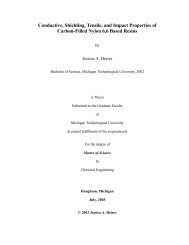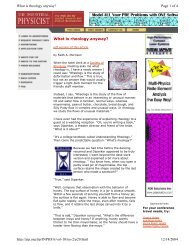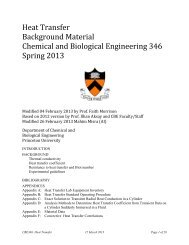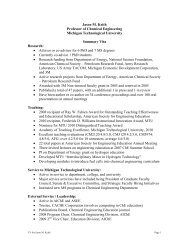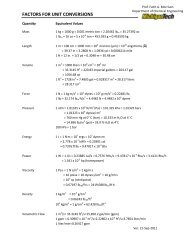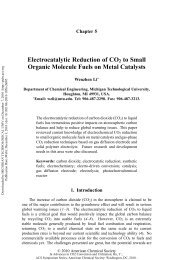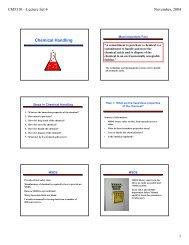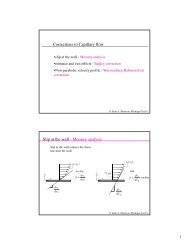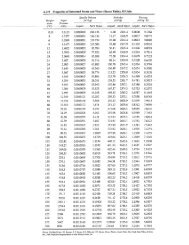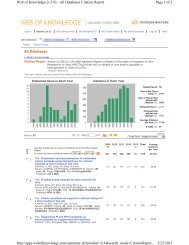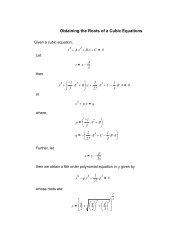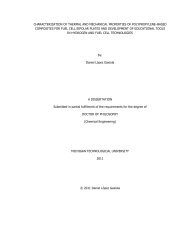CM4710 Biochemical Processes - Chemical Engineering
CM4710 Biochemical Processes - Chemical Engineering
CM4710 Biochemical Processes - Chemical Engineering
Create successful ePaper yourself
Turn your PDF publications into a flip-book with our unique Google optimized e-Paper software.
<strong>CM4710</strong> <strong>Biochemical</strong> <strong>Processes</strong><br />
An introduction to<br />
1. <strong>Biochemical</strong> engineering as a subdiscipline<br />
2Mi 2. croorganisms and dbi omolecules<br />
l<br />
3. Bioreactors and their analysis<br />
4. Bioseparation unit operations<br />
5. Genetic <strong>Engineering</strong> Basics / Applications
<strong>CM4710</strong> <strong>Biochemical</strong> <strong>Processes</strong><br />
Instructor:<br />
Dr. David Shonnard<br />
Time:<br />
12:05 - 12:55 MWF<br />
Location:<br />
room 303 MEEM
<strong>CM4710</strong> <strong>Biochemical</strong> <strong>Processes</strong><br />
Advantages<br />
1. Become more specialized in an emerging<br />
high technology field<br />
2. Open the door for positions in the<br />
pharmaceutical, biorenewables, and<br />
biomedical industries
Bacteria: E. coli<br />
Pili<br />
Flagella
Bacteria: Corynebacterium
Bacteria: Gram + Cell Wall<br />
Faculty Resource Center<br />
Sylvester McKenna & Devabrata Mondal<br />
Long Island University, Brooklyn Campus
Bacteria: Gram - Cell Wall<br />
Faculty Resource Center, Sylvester McKenna & Devabrata Mondal<br />
Long Island University, Brooklyn Campus
Structure of Proteins<br />
Disaccharides<br />
Table sugar<br />
Milk sugar
Double Helix<br />
structure of DNA<br />
DNA is always found<br />
in complimentary<br />
strands in a double<br />
helixh havingA<br />
matched with T and G<br />
matched with C. On<br />
RNA, U replaces T.
Bioreactor Analysis<br />
1 dX<br />
X dt = µ max<br />
S<br />
K S<br />
+ S<br />
µ = D<br />
K<br />
S = S<br />
D<br />
µ max<br />
− D<br />
X = Y M K<br />
X / S<br />
(S o<br />
− S<br />
D<br />
µ max<br />
− D )
Recombinant<br />
DNA<br />
Cloning<br />
Procedure<br />
Plasmid<br />
1. Identify a cloning vector<br />
(Plasmid)<br />
2. Identify a target DNA<br />
3. Open up plasmid and target<br />
DNA using restriction<br />
endonuclease<br />
4. Join target DNA with<br />
cloning vector<br />
5. Introduce recombinant DNA<br />
construct into host cell<br />
6. Isolate cells with cloned DNA
Introduction to <strong>Biochemical</strong> Industry<br />
Definition of <strong>Biochemical</strong> <strong>Processes</strong><br />
"A process that uses living cells or<br />
"A process that uses living cells or<br />
biomolecules to carry out a chemical<br />
transformation leading to the production<br />
and ultimate recovery of valuable<br />
products".
Short History of <strong>Biochemical</strong> <strong>Processes</strong><br />
• Ancient Uses of Microorganisms (Before 1800 A.D.)<br />
• Caveman to Earliest Recorded History --- aging of meats, cheeses, and<br />
alcoholic beverages.<br />
• Ancient Chinese and Japanese -- soy sauce from fermented beans.<br />
• Ancient Egyptians (2500 B.C.) -- malting of barley and beer<br />
fermentation.<br />
• Mesopotamian tablet records brewing of wine and beer are established<br />
profess ions in 2000 B.C.<br />
• Columbus lands in North America to find the native peoples drink beer<br />
made from corn.<br />
• Chinese use moldy soy bean curd to clear up skin infections (1000<br />
B.C.)<br />
• Central American native peoples use fungi to treat infected wounds.<br />
• Middle Ages experimenters learn how to improve the taste of wine,<br />
bread, beer, and cheese.<br />
• Mankind did not know that these fermentation processes were being carried out<br />
by microscopic forms of life.
Old Science (1800-1940)<br />
• From the discovery of the role of microscopic life in fermentations to the use of<br />
non-sterile fermentations in organic molecule synthesis.<br />
• 1803 -- A French scientist, L.J. Thenard, announces that yeast used in<br />
wine making were alive and that they were responsible for the<br />
formation of alcohol. His findings were rejected by supporters of the<br />
conventional notion that fermentations were chemical processes only.<br />
• 1857 -- Louis Pasteur, another French Scientist, proves Thenard is<br />
correct. Showed that t certa indise seases ses are caused by microorganisms.<br />
Birth of modern Microbiology. Concludes that certain<br />
microorganisms are destroyed by other microorganisms and suggests<br />
that human disease could be cured by pitting microbe against microbe.<br />
• 1901 -- Rudolf Emmerich and Oscar Low, University of Munich,<br />
isolate a primitive antibiotic, pyocyanase, from Pseudomonas<br />
aeruginosa, a bacterium. Several hundred patients were successfully<br />
treated, but quality control was poor and pyocyanase was abandoned<br />
as too hazardous.
Old Science (1800-1940)<br />
• 1900 - 1940<br />
– > Production of bakers yeast in deep, aerated tanks.<br />
– > World War I -- Chaim Weismann solves a serious British<br />
ammunition problem by converting corn maize mash into<br />
acetone, which is used in the manufacture of the explosive<br />
cordite.<br />
– > 1923 -- Pfizer opens the first commercial successful plant for<br />
citric acid production from sugar.<br />
– > 1928 -- Alexander Fleming discovers penicillin.<br />
• Simple organic molecules such as glycerol, lactic acid, and butanol are<br />
fermented on an industrial scale by fermentations
New Science (1940-late 1970s)<br />
Fermentations of complex organic molecules requiring sterile conditions which<br />
protect the non-robust, highly selected microbial strains from competition by<br />
other microorganisms<br />
• 1940 -- Drs. Howard Flory and Ernst Chain (England) and three<br />
American pharmaceutical companies (Merck, Pfizer, and Squibb) mass<br />
produce penicillin for WW II effort.<br />
• Pioria Illinois -- 1940's, government worker discovers a new strain of<br />
Penicillium on a moldy cantaloupe which can produce 200 times more<br />
penicillin than Fleming's strain.<br />
• Selman A. Waksman of Rutgers University discovers a new antibiotic,<br />
streptomycin, for the treatment of tuberculosis.<br />
• Fermentive syntheses of amino acids, vitamins, cortisone, nucleic acids,<br />
polysaccharides, and enzymes.
Era of Molecular Biology (late 1970s-Present)<br />
1973 Herbert Boyer (University of California, San<br />
Francisco) and Stanley Cohen (Stanford University)<br />
establish recombinant DNA technology<br />
http://web. mit.edu/ edu/invent/iow/boyercohen .html<br />
The discovery of recombinant DNA technology and<br />
the birth of genetic engineering allows for the<br />
efficient production of compounds not indigenous to<br />
the host microorganism.
<strong>Biochemical</strong> <strong>Engineering</strong> as a Discipline<br />
Work in a team environment with chemists, biochemists,<br />
microbiologists, and chemical engineers.<br />
• Steps in the development of a new biochemical process and roles<br />
professionals play.<br />
– 1. Identify a desired reaction or product (chemist, biochemist).<br />
– 2. Identify key enzyme(s) or microorganism (biochemist,<br />
microbiologist).<br />
– 3. Process development (chemist, biochemist, microbiologist,<br />
chemical engineer).<br />
– 4. Design of bioreactor and recovery unit operations (chemical<br />
engineer).<br />
–5. Metabolic <strong>Engineering</strong>: application of engineering analysis to<br />
metabolic pathways within microorganisms to improve product<br />
yields.



